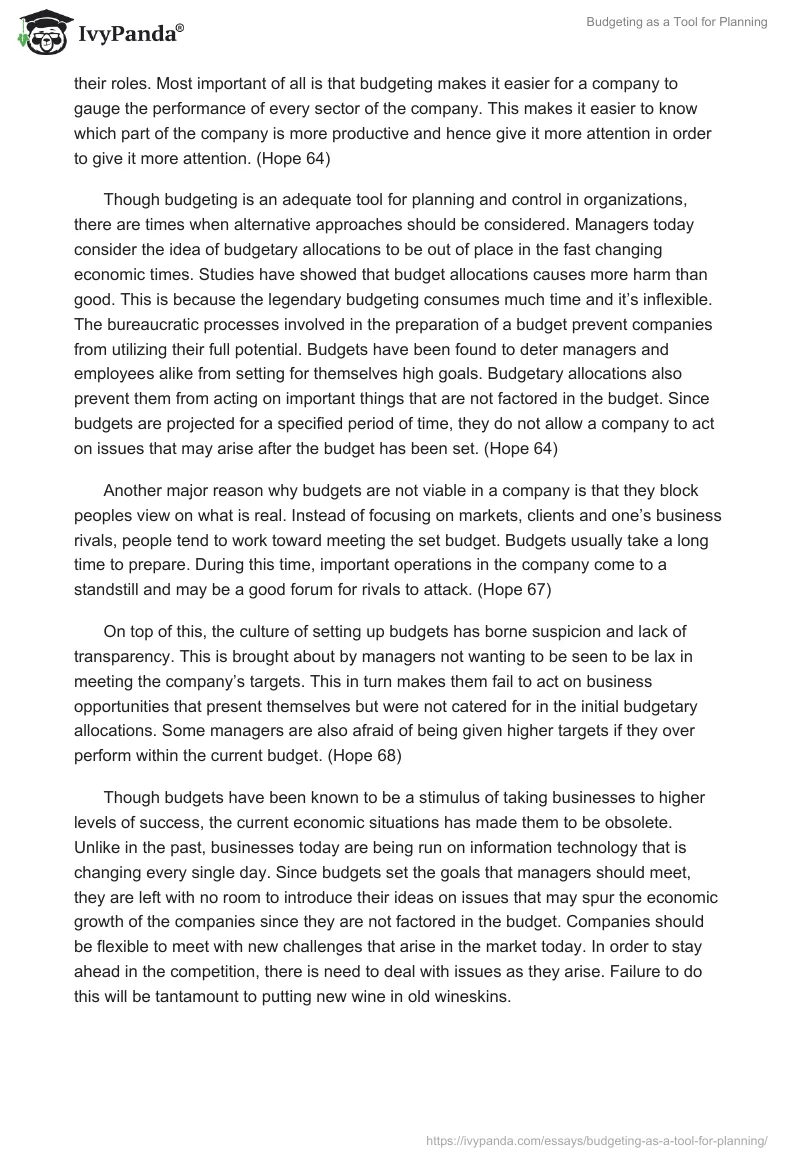A budget is a broad official plan that approximates the likely expenses and earnings of a particular organization in a given time frame. Budgeting illustrates the whole process of organizing and putting a budget to use. Budgets are important tools for preparing and managing investments. For this reason therefore, budgeting is essential in every aspect of life. Companies, countries and individuals all need a budget for them to run smoothly. Big and small companies both need a budget to know the most useful policies in expansion of their businesses. Budgeting helps an organization to determine the amount of money needed in a particular project and gives an insight on the marketing strategies required. It also helps the company in planning for both short and long term goals. (Murran)
Companies use budgeting to plan for their income and resources. If the earnings of a company are steady, it may invest some of it in assets thus increasing its capital base. For this to be effective, a company uses budgeting to look at the business prospects available and to learn ways of putting them in to maximum use. A company will also look at its current profits and use budgeting to plan for future events. (Hope 60)
Basically, a budget helps in planning and controlling the activities of a business. The planning process entails putting all the thoughts and strategies in to tangible terms. Proper planning in the early stages creates the structure for control which a company needs in factoring out every department in the budgeting process. In today’s world where the tempo and intricacy of business has made managers to focus only on the custom problems, planning and control helps the management to look at each department in a more thorough way. This is because in preparing for budget estimates, managers are called upon to look at the interior affairs of every sector in the company. (Hope 62)
Since a budget is an outline of all the company’s activities, it alerts the management on deviations from expectations which may need to be acted upon. When there is deviation from the main cause of action, managers can modify their strategies to alter a product or give a face-lift to a promotion campaign. They might also borrow money to address the deficit. Since budgeting includes all the segments in a company, it coordinates all the areas of the company and exhibits to managers the connection of their roles. Most important of all is that budgeting makes it easier for a company to gauge the performance of every sector of the company. This makes it easier to know which part of the company is more productive and hence give it more attention in order to give it more attention. (Hope 64)
Though budgeting is an adequate tool for planning and control in organizations, there are times when alternative approaches should be considered. Managers today consider the idea of budgetary allocations to be out of place in the fast changing economic times. Studies have showed that budget allocations causes more harm than good. This is because the legendary budgeting consumes much time and it’s inflexible. The bureaucratic processes involved in the preparation of a budget prevent companies from utilizing their full potential. Budgets have been found to deter managers and employees alike from setting for themselves high goals. Budgetary allocations also prevent them from acting on important things that are not factored in the budget. Since budgets are projected for a specified period of time, they do not allow a company to act on issues that may arise after the budget has been set. (Hope 64)
Another major reason why budgets are not viable in a company is that they block peoples view on what is real. Instead of focusing on markets, clients and one’s business rivals, people tend to work toward meeting the set budget. Budgets usually take a long time to prepare. During this time, important operations in the company come to a standstill and may be a good forum for rivals to attack. (Hope 67)
On top of this, the culture of setting up budgets has borne suspicion and lack of transparency. This is brought about by managers not wanting to be seen to be lax in meeting the company’s targets. This in turn makes them fail to act on business opportunities that present themselves but were not catered for in the initial budgetary allocations. Some managers are also afraid of being given higher targets if they over perform within the current budget. (Hope 68)
Though budgets have been known to be a stimulus of taking businesses to higher levels of success, the current economic situations has made them to be obsolete. Unlike in the past, businesses today are being run on information technology that is changing every single day. Since budgets set the goals that managers should meet, they are left with no room to introduce their ideas on issues that may spur the economic growth of the companies since they are not factored in the budget. Companies should be flexible to meet with new challenges that arise in the market today. In order to stay ahead in the competition, there is need to deal with issues as they arise. Failure to do this will be tantamount to putting new wine in old wineskins.
Works Cited
Hope & Fraser. Beyond budgeting: how managers can break free from the annual performance trap, 50-75. Harvard Business Press. 2003. Print.
Murran, Jean. Budget, n.d. Web.


